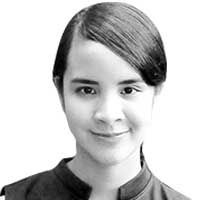Moving with salt, wings, bombs


The sixth singapore biennale
A space that samples Carlos Villa’s body of work is among the first stops in our tour of the Singapore Biennale. Villa — Filipino-American artist and activist, migrant and man of the world — was promiscuous with his materials. It is a room with wings: feathers loose or tightly bundled, sheets of paper that rustle with restless marks. There is heavy graphite, interlocking loops of blood on paint, and insistent, repetitive gestures applied with colored pencil. Villa’s formal studies flirted with the abstract expressionists’ language which was gaining ground in global modernism, yet the materials he introduced at times pointed to the Pacific. Shifting and sliding between forms and worlds, here the artist-migrant sets the tone for convergence and exploration.
Running until March 22 and organized by the Singapore Art Museum, the sixth iteration of the Singapore Biennale, “Every Step in the Right Direction,” is stretched across 11 sites. Rather than propping up a theme, the Biennale offers an open proposition. The artistic director, Dr. Patrick Flores, took its title from Salud Algabre’s retort when asked about the failure of an uprising. No movement fails, counters the Filipina revolutionary who took part in a peasant uprising in the 1930s, “each one is a step in the right direction.”
Dr. Flores’ practice as a curator is informed by his work as an art historian. If form in art emerges from what he calls a whorl of ecology, materiality, and sociality, “to thematize art in relation to a position,” he says, “whether issue, or medium or procedure of formalization, contributes to this polarization, and to the alienation of art from its lifeworld.” Doing away with a theme or a category that is fixed and final came from wanting, as he put it, “to give the whorl a chance to generate its own energy.”
There is in Dr. Flores’ work an abiding interest in modes of making, and he traces this back to an exhibition in 2001, called “Crafting Economies (CCP)” which looked at “craft as a mode of producing the contemporary in Asia.” A curator’s sensitivity to form that is emergent, to the conditions of making that pound it into shape, allowed it to migrate and conjure atmosphere and world displaces the authority of a theme. Working with six curators, he allowed them to reflect on the ethical and the geopoetic — “the poetics that is reared in a certain place” and refers back to it — in their explorations of artists.
It is this exciting sense of emergence and becoming that we glean immediately in Villa. The energies of places passed through animate other works that succeed him at the National Gallery Singapore. Not far from Villa, there rests, in between the staircase’s geometries and liquid light, the work “Black—Hut, Black—Hut” by Boedi Widjaja. It is a concrete structure infused with salt, referencing, we’re told, the raised floors of vernacular houses such as the Javanese joglo, the Queenslander house, and the Malay house. Materially, it participates in the ecosystem of both organic and concrete, shuttling in between the lived experiences of rootedness and mobility. It isn’t surprising that Widjaja is a migrant artist trained as an architect.
The Biennale constantly prompts us to move. Place here is encountered as a vast quilt of mutable materials and moving presence. Veronica Troncoso’s “Telling Stories from Outside and Inside” contends with flux. The Germany-based artist considers it an archive: recordings played out on headphones, fragments culled from conversations about coming to Singapore as migrant workers. The individual testimonies, where the speaker often goes unnamed, alternately register as fact or forms of longing, the primal need to belong to a place or to a language.
The disembodied voice that speaks to the restlessness of exile resurfaces in “Never Real Historians, Always Near Poets.” Vong Phaophanit and Claire Oboussier’s video — in two channels that fork and join like waterways — is an intimate address. You live in a bomb ecology, says the voice to an unnamed uncle. “‘Don’t touch’ was the first words the children learned.” The work considers a family history of living in flight, moving to France after a regime change in Laos. Even in the VR installation of Laurie Anderson and Hsin-Chien Huang (“La Camera Insabbiata”), we enjoy the fantasy of unfetteredness, entangled with the unbearable anxieties of being adrift.
Other video works rooted to localities, lived or reimagined, are a cross between documentary, fiction, and diary. Land is sensate in Vandy Rattana’s “Monologue Trilogy” and Wu Tsang’s “One emerging from a point of view.” They take the route of micro-histories to address large devastations and the refugee crisis. And then there is Karolina Bregu?a’s “Square” at Gillman Barracks, where the cyclicality and repetition of the everyday is jolted by some magic (a singing sculpture in the bush, that wants to ask a question). There is humor in the joining of banality and belief. “My sister is also talking to the bush,” says one. “Do you think it’s an epidemic?” With screens arranged around the room, the disembodied singing is intermittent and everywhere.
Less concerned with the hard edges that arbitrarily define the boundaries of places, the Biennale was not easy to map — where are we, in which country, at what time? Moving itself becomes as a kind of mapping. “Since the Biennale was a collective enterprise,” says Dr. Flores, “curators tried to reach out, cede space, cohabit, live with strangers, host guests, be patient with unexpected intrusions.” It is a welcoming call for steps and directions.



















